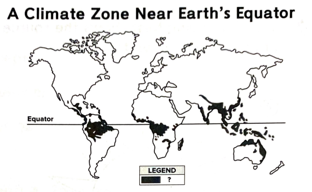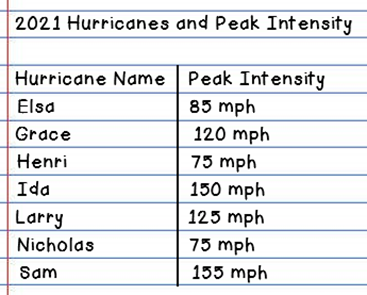Venus is sometimes called the “evening star.” Why is this NOT a correct statement?
A. Venus is a planet, not a star
B. Other stars can be seen in the sky after sunset.
C. Only planets can be seen in the sky after sunset.
D. Venus can be seen during the day, but not in the evening.
A. Venus is a planet, not a star
Susan made observations about outside events she noticed throughout the day. The day began with rain. Susan saw puddles on the road. The rain stopped and the sun began to shine. The puddles disappeared. Later, clouds began to form in the sky.
How do the parts of the water cycle relate to the events that Susan saw?
A. The rain was condensation. The sun making the puddles disappear was evaporation. The clouds were formed by precipitation.
B. The rain was precipitation. The sun making the puddles disappear was condensation. The clouds formed by evaporation.
C. The rain was evaporation. The sun making the puddles disappear was precipitation. The clouds were formed by condensation.
D. The rain was precipitation. The sun making the puddles disappear was evaporation. The clouds were formed by condensation.
D. The rain was precipitation. The sun making the puddles disappear was evaporation. The clouds were formed by condensation.
A weather forecaster predicts that there will be high humidity and high levels of precipitation in an area. How does humidity differ from precipitation?
A. Humidity is water that falls as a liquid, and precipitation is water that falls as a solid.
B. Humidity is water that falls as a solid, and precipitation is water that falls as a liquid.
C. Humidity describes gaseous water mixed in air, and precipitation is liquid or solid water.
D. Humidity describes the amount of air pressure in the atmosphere, and precipitation describes the type of cloud.
C. Humidity describes gaseous water mixed in air, and precipitation is liquid or solid water.
Which climate zone experiences the greatest variety of weather with the seasons of the year?
A. polar
B. tropical
C. tundra
D. temperate
D. temperate
What are latitude and longitude lines?
A. Latitude lines go horizontally across the Earth, while longitude lines go vertically.
B. Longitude lines go vertically across the Earth, while latitude lines go vertically.
C. They are both squiggly lines that go across the Earth.
D. Longitude is another word for equator. Latitude lines go vertical.
A. Latitude lines go horizontally across the Earth, while longitude lines go vertically.
Which of these can be made of gases, dust, and hundreds of billions of stars?
A. a galaxy
B. a planet
C. a solar system
D. a constellation
A. a galaxy
Gavin and Lily are having glasses of iced tea with their lunch. As their drinks sit in the room temperature air while they eat lunch, they observe water droplets forming on their glasses. Which phase of the water cycle do they observe?
A. runoff
B. evaporation
C. precipitation
D. condensation
D. condensation
Precipitation occurs when water moves from the atmosphere to Earth’s surface. The water can be in liquid or solid form. Which two forms of precipitation consists of solid water?
A. hail and rain
B. sleet and rain
C. hail and sleet
D. rain and show
C. hail and sleet
Which factors affect temperature and precipitation, within a climate zones?
A. Latitude, elevation and proximity to water
B. Latitude, number of cities and time of year
C. Elevation, types of plants and time of year
D. Elevation, number of rivers and proximity to water
A. Latitude, elevation and proximity to water
Which type of cloud can you see shapes in the sky?
A. Cumulonimbus
B. Stratus
C. Cumulus
D. Cirrus
C. Cumulus
Our solar system is in the Milky Way galaxy. Which statement is NOT true of all galaxies?
A. They contain billions of stars
B. They can be seen from Earth
C. They are constantly moving through space.
D. They contain gas and dust where new stars form.
B. They can be seen from Earth
Romell is creating a model of the water cycle. He places a small cup with some water inside a plastic bag and sets the bag near a sunny window. He checked the model after one day. What did the model show?
A. cloud formation
B. only water evaporation
C. only water condensation
D. both water evaporation and condensation
D. both water evaporation and condensation
When Brian complained about the stormy weather, his mother told him that the barometer showed that the air pressure was increasing. What does that tell Brian about the weather?
A. The weather will get worse
B. Fair weather is approaching
C. There will soon be a snow storm.
D. Nothing, air pressure doesn't affect the overall weather of a place.
B. Fair weather is approaching
The map shows a climate zone.

Which of the following best completes the map legend?
A. polar
B. tropical
C. subarctic
D. temperate
B. tropical
Centerville and Poplar Bluff are both cities within the Temperate climate zone. Centerville averages 25 inches of precipitation per year. Poplar Bluff averages 43 inches. Which of these factors could account for the greater precipitation at Poplar Bluff?
A. more trees
B. fewer animals
C. greater elevation
D. nearness to an ocean
D. nearness to an ocean
Which best describes the outer planets of our Solar System?
A. large, rocky, dense
B. small, rocky, dense
C. large, gaseous, ringed
D. small, gaseous, ringed
C. Large, gaseous, ringed
June is making a model to show how water evaporates from the ocean. Which items can she use in her model?
A. flashlight and tea kettle
B. stove burner and pot of water
C. thermometer and heating pad
D. heat lamp and bowl of salt water
D. heat lamp and bowl of salt water
Tuesday - no clouds - 30 degrees Fahrenheit
Wednesday - cloudy - 30 degrees Fahrenheit
Thursday - party cloudy - 36 degrees Fahrenheit
Friday - cloudy - 36 degrees Fahrenheit
Which day would snow have most likely fallen?
A. Friday
B. Tuesday
C. Thursday
D. Wednesday
D. Wednesday
Johanna is explaining to her friend how to determine the climate of an area. Which instruction is she most likely to give her friend?
A. Measure the highest and lowest temperatures for one day.
B. Find the average weather conditions over a period of many years.
C. Find the average weather conditions over a period of many years.
D. Record the precipitation and the wind speed for several months.
B. Find the average weather conditions over a period of many years.
Ralph and Thea are investigating how surface area affects the evaporation of water. They pour the same amount of water into a shallow dish and a tall, narrow jar. Ralph says they should use hot water instead of water at room temperature. Which of the following best describes Ralph’s statement?
A. opinion
B. prediction
C. conclusion
D. observation
A. opinion
Which feature do all inner planets have in common?
A. They have rings
B. They have moons
C. They have rocky surfaces
D. They have thick atmospheres
C. They have rocky surfaces
Surface water evaporates as part of the water cycle. The water in the air then turns into clouds during condensation. Which statement describes how water changes state during this process?
A. The water in the air is a gas; it stays as a gas to form clouds.
B. The water in the air is a gas; it turns into a liquid to form clouds.
C. The water in the air is a liquid; it turns into a solid to form clouds.
D. The water in the air is a solid; it turns into a liquid to form the clouds.
A. The water in the air is a gas; it stays as a gas to form clouds.
You wake up one morning and the sky is filled with a blanket of stratus clouds low in the sky. What can you predict the weather will be like based on these clouds?
A. light rain all day
B. heavy rain all day
C. clear and sunny day
D. strong thunderstorms
A. light rain all day
Deserts in the temperate zones can be extremely hot in the afternoon and below freezing at night. Which answer best explains why this happens?
A. Temperate deserts are found at high elevations, where the Sun and the wind are much stronger. This creates less extreme temperature changes.
B. Temperate deserts lack trees and grass. With no trees, the Sun shines directly down and causes it to get hot in the day, and with no grass, the heat can’t escape at night.
C. Temperate deserts have very little cloud cover and no humidity. This means that more energy from the Sun reaches the desert in the day, but that heat can escape quickly at night.
D. Temperate deserts have higher rainfall than other kinds of deserts. Warm rain during the day produces warm breezes in the desert. Cooler rains at night draw warm air away from the desert.
C. Temperate deserts have very little cloud cover and no humidity. This means that more energy from the Sun reaches the desert in the day, but that heat can escape quickly at night.

What is a verified observation that a student could make?
A. Hurricane Sam was the largest hurricane.
B. Hurricanes Ida and Sam had similar peak intensity.
C. I think Hurricane Grace is the strongest because that is my sister’s name.
D. Hurricanes Henri and Nicholas did not cause damage because they were the slowest.
B. Hurricanes Ida and Sam had similar peak intensity.